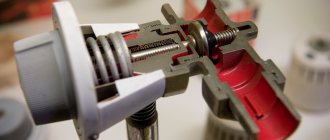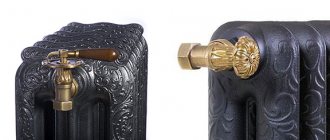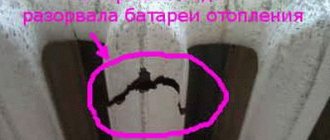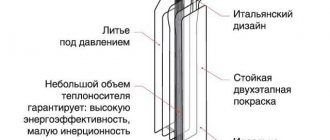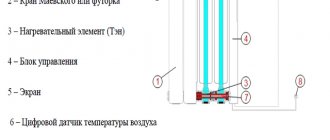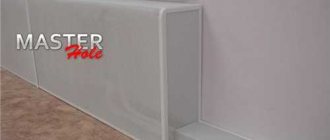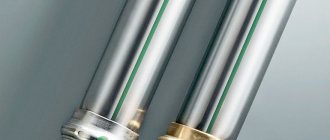What types of radiator plugs are there? How to identify a product with a left or right thread? How does a radiator cap with an automatic air vent work? How to seal these fittings, and with what piping elements to connect them? Let's figure it out.
Set of plugs and fittings for connecting an aluminum radiator.
Network connection
To independently connect to propylene pipes, you need to have a special soldering iron.
There are two connection options:
1. If the radiator valve is made of propylene, then its plastic pipe is connected by soldering directly to the connection. Then the American metal end is unscrewed from the tap and screwed into the radiator liner, using flax winding with paste or FUM tape to seal the connection. After which the “American” is reassembled and the union nut is tightened with a wrench.
2. If the radiator valve is metal, then to connect to the plastic liner use a combined detachable coupling with an internal thread. This coupling is similar in connection principle to the metal “American” one, but the union nut is located on a plastic solder end. The plastic part of the coupling is soldered to the supply pipe through a connecting fitting. The coupling is disassembled, the mating metal part is screwed onto the valve body and then assembled again, tightening the union nut with a wrench.
1 - “American”; 2 - ball valve; 3 - combined detachable coupling; 4 - polypropylene coupling; 5 - polypropylene liner
When connecting to a metal supply, you must also first connect the ball valve or thermostat to the pipe. It is not necessary to have welding skills - connecting the shut-off valves to the pipe can be done using a threaded connection. To do this, it is necessary to cut a thread on the cut part of the eyeliner. They do this using a clamp. A set of sockets and a mandrel with one or two handles is quite expensive, but you can buy only one socket head of a specific size, and use a regular gas wrench as a mandrel with a handle. The sequence of work will look like this:
- the supply pipes are cut with a grinder to the required size, trying to ensure that the cutting plane is perpendicular to the axis of the pipe;
- clean the end of the pipe from rust and use a file to make a small chamfer;
- Lubricant is applied to the working section of the pipe and the clamping cutters;
- place the head on the chamfer;
- center it relative to the axis of the pipe;
- Holding the head with your hand, using a gas wrench, begin to turn it clockwise.
As a result, you need to get a section with a thread of a size approximately equal to the long part of a standard bend (for example, for a 3/4 - 45 mm pipe).
Then a lock nut (for Dу 3/4 its thickness is 9 mm) and a coupling (for Dу 3/4 its length is 36 mm) are screwed onto this section. Combine the inlet hole of the ball valve with the connection and move the coupling from the connection to the threads of the valve body (naturally, using flax or FUM tape). Then a winder is screwed onto the thread next to the coupling and the lock nut is driven over.
1 - “American”; 2 - valve; 3 - coupling; 4 - lock nut; 5 - threaded liner
Important! The faucet handle should be positioned up or away from the wall to make it easy to use. After the shut-off valve (or thermostat) is rigidly and hermetically connected to the supply line, it is connected through the “American” to the radiator liner
After the shut-off valve (or thermostat) is rigidly and hermetically connected to the supply line, it is connected through the “American” to the radiator liner.
Hello, dear forum users! I have the following question for you: - how to determine on heating radiators where the left and right threads are? How are they different from each other? And is it possible to determine this on batteries when the plug on the cast-iron radiator is already tightened?
Joint repair
To carry out repairs you will need:
- special radiator key;
- gas key No. 2 or No. 3.
We will assume that the radiator has been removed. It must be laid on a flat surface. Then remove the plugs and fittings (plugs with holes for pipes) using a gas wrench.
The radiator sections are connected to each other by nipples. This is a short cast iron pipe with an external pipe thread (half right-handed, half left-handed) and an internal hole in which there are two protrusions.
These protrusions are where the edges of the radiator key will rest. Essentially, these are stops.
At this stage, you will need an assistant who will fix the heating device in a stationary position. The key is inserted into the hole of the section so that the edges of the tool rest against the protrusions of the nipple. Now you need to forcefully turn the key at least a quarter of a turn.
The thing is that long-term operation of cast iron batteries, where a high-temperature coolant is used, creates conditions under which the nipple and section of the device are soldered together. The result is a monolith.
Therefore, great efforts will have to be made to break these ties. As soon as the nipple moves a little from the dead center, move on to the second parallel element. You cannot untwist the sections on one side only, otherwise a skew will occur, which will complicate subsequent operations.
This way all sections are disassembled. Now you need to clean the joint surfaces with a wire brush and sandpaper. All you need to do is remove the rust.
Be sure to inspect the nipples; if their condition is in doubt, it is better to replace them with new ones
Focus on the thread
At this stage it is best to wash the battery sections. A hose stream and a pin (wooden or metal) will do the job perfectly.
After which you can proceed to assembly, having previously prepared the gaskets. You can make them yourself from heat-resistant paranit or rubber 1 mm thick. Currently, craftsmen suggest using silicone sealant, which can withstand high temperatures.
Reassembling the battery is carried out in the reverse order. Be careful when tightening nipples
It is important here not to twist, so as not to compress the gasket to a critical level. It just might break
As with disassembly, the two nipples must be screwed in alternately.
Situations often occur when the stops inside the nipple become covered with rust due to prolonged contact with the coolant. And under pressure from the radiator key, these stops are cut off. What to do in this case, because the sections simply cannot be untwisted. Option one is to break the section where the fistula appeared.
This can be done in two ways:
- Just break the battery section with a sledgehammer. Do this carefully so as not to break the good elements.
- You can cut it with a grinder. But the connection point will still have to be broken with a hammer.
General recommendations
Experienced craftsmen and professionals recommend taking into account the following points:
- When using a cast iron radiator plug on heating appliances, caution should be exercised. The fact is that cast iron is easily compressible, but is considered a rather fragile material. Therefore, even a slight mechanical impact or impact on a hard surface can cause the formation of microcracks. As for steel products, they are more reliable in this regard.
- When studying materials for the assembly and installation of heating devices, there are recommendations for using ordinary paint for more airtight connections. To some extent, these statements are true, but it should be noted that such connections do not have a very attractive appearance, and when disassembling them you may encounter certain difficulties. It is important to understand that modern heating devices and their additional accessories do not require painting.
Selecting and installing radiator plugs is not difficult, but you need to approach this process quite responsibly. It is very important to select matching materials, correctly determine the type of thread and size of the plug, as well as its purpose. By following the recommendations of professional technicians, you can avoid many problems during the operation of the heating system, including batteries and radiators.
Dismantling cast iron radiators
To dismantle such heating devices yourself, you will need the following tool:
Dimensions of cast iron battery.
- Pipe wrench number 3, for loosening the locknut and fitting.
- Pipe cutter for cutting pipes or grinder.
- Hacksaw for metal.
- Chisel.
- Hammer and sledgehammer.
- Brush for removing rust.
Work to dismantle such heating devices is usually carried out in the summer, when the heating system is turned off. Before starting dismantling work, it is necessary to drain the water from the heating pipelines.
Then, using a pipe wrench, the locknuts located on the water supply pipes are unscrewed, the fittings are unscrewed, and the radiator is removed from the brackets.
If the locknuts cannot be unscrewed, the coolant supply pipes are cut off and the device is dismantled.
Basic elements for radiator installation
In most cases, radiators are sold assembled; to operate, the device only needs to be fixed on the wall and connected to the heating system. However, in addition to this, you will need to purchase additional devices. These include the following:
- Pass-through plug for a cast iron radiator in an amount of at least 2 pieces. The device has holes on both sides in which threads are cut.
- Plugs that are screwed into the radiator body to prevent coolant leakage.
- Mayevsky taps for bleeding air from a heating device.
- Devices for installing radiators, these can be metal anchors or special brackets.
The number of radiator sections is determined by the need for thermal energy, so the length of the heating device is increased or shortened.
Modern specialized stores offer radiators and a full set of accessories for their installation. This allows you to select elements of the same color in accordance with the color of the heating device. In addition, in this case it is possible to select the most compatible materials. For example, if the battery is made of cast iron, then the plugs should also be cast iron. It is not recommended to use a plug for a cast iron radiator on copper heating appliances.
Due to the high risk of galvanic corrosion effects, it is very important to consider the combination of materials. In addition, individual metals tend to form a galvanic couple, in this case the cast-iron radiator plug becomes a cathode, and the material from which the pipe is made turns into an anode. As a result, the service life of the heating device is significantly reduced.
Preparing for disassembly
At this stage, you need to prepare all the necessary tools and remove the battery from its mounting location. For work, depending on the type and condition of the radiator, you may need the following tools:
- radiator (nipple) key;
- an adjustable wrench or a set of wrenches with different head sizes;
- autogen or grinder;
- construction hair dryer;
- hammer, sledgehammer;
- chisel.
Tools for disassembling radiators
A nipple wrench is an iron rod with a spade-shaped head at one end, and a hole or bent “ear” at the other. A tool purchased in a store has serifs, the distance between which is equal to the width of the heating radiator sections. They will help you find the location of the required nipple nut.
After preparing the tools, it is necessary to arrange a place for disassembling the radiator. A floor or a sturdy table will do. It is necessary to take into account that dirty water will flow out of the battery, and do not forget to place a waterproof cloth under it.
Harness
Which shut-off and control valves are mounted on the connections in front of the passage plugs?
Here are some typical options.
- Pair of ball valves. They allow you to completely turn off the device in case of repair or replacement without resetting the entire circuit.
A pair of valves completely cuts off the device from the connections.
- Throttle and ball valve. The throttle provides the ability to manually adjust heat transfer.
- A pair of chokes makes it possible to perform basic balancing of the system (limiting the passage of heating devices closest to the boiler) and subsequently regulate the heat transfer of the device.
- Finally, the combination of a throttle with a thermal head makes it possible to adjust the heat transfer completely automatically: the set temperature will be maintained in the room with acceptable accuracy.
Features of mounting radiators
The most demanding fastenings and bases in terms of strength are cast iron radiators. In addition to the weight of the product itself, the internal volume of the section also plays a certain role. If the popular series of cast iron radiators MS-140 has a volume of almost 1.5 liters, then for an aluminum radiator it is no more than 0.5 liters, and for bimetallic ones even less.
When calculating the number of brackets, they are guided by the provisions of clause 3.25 of SNiP 3.05.01–85 - one bracket per 1 sq. m of heating area of the cast iron battery (but there must be at least three of them in total). The heating area of one section depends on its type. For example, for the M-140 it is 0.254 square meters. m, and for a battery of 12 sections you already need four brackets.
If the battery is mounted on three brackets, the mounting diagram looks like this: two points at the bottom, one in the middle at the top. Four brackets are installed in pairs one above the other. And the bend of the bracket should wrap around the neck of the radiator (the junction of two adjacent sections).
Bimetallic and aluminum radiators are fastened according to the same scheme as cast iron ones. And the reason is no longer the weight of the battery and coolant, but the thin walls of the steel liners of bimetallic products, the low resistance to mechanical loads of aluminum and the weak strength of the threaded connections of individual sections of both types of radiators. Therefore, they also need at least three points of support.
Cast iron radiators are installed on brackets with dowels fixed in concrete and brick walls. For bimetallic and aluminum radiators, the brackets can also be attached to wooden walls.
In other cases, for installation it is necessary to use two floor stands with the upper part of the radiator fixed to the wall. If the number of sections is more than ten, then three stands are needed.
Step-by-step description of dismantling work
A few words about when it may be necessary to disassemble a heating battery:
- In case of replacing an old radiator with a new one that has greater performance and better appearance.
- If necessary, add additional sections for the battery.
- If it is necessary to replace a separate section or gasket that has leaked.
The instructions begin with preparing the necessary tools:
Step #1: preparing tools
Photo of nipple wrench
Gas key sample
Advice: a nipple wrench, given the fact that it is very rarely needed on the farm, and its price is not the lowest, it is recommended not to buy, but to rent. This will save the family budget.
Step #2: Disconnecting the Battery
Before disassembling an aluminum or cast iron radiator, you must disconnect it from the heating system. To do this, it is imperative to turn off the heating and drain the water from the riser, otherwise you will simply flood the room and get burns.
Advice: before starting dismantling, it is recommended to cover the floor under the radiator with film, rags, or at least newspapers to avoid contact with residual liquid that may end up in the circuit even after draining the riser.
Further, depending on the complexity, three situations can be distinguished:
- Polypropylene pipes. In this case, the coupling connection, as a rule, is twisted with bare hands, without causing any difficulties.
- Steel new. With some effort, you will most likely be able to untwist the inlet and outlet cords of the battery using a gas wrench.
Disconnecting new steel pipes
- Old steel or cast iron pipes. First we try, removing the paint from the joint with a blowtorch and a metal brush, we try to unscrew the connection as described in the previous version. But in systems that have worked for a long time, this most often does not give results, and then we simply cut off the runoff with a grinder or an autogen.
Cutting old squeegees using a grinder
After disconnecting the battery from the pipes, remove it from the hooks and lay it on a flat surface.
Step #3: disassembling the radiator
Battery sections disconnection diagram
A piece of pipe or crowbar
The battery can be cast iron, aluminum or bimetallic.
The most difficult option to analyze is the first one listed, so let’s start with it:
- How to disassemble a cast iron heating radiator on your own:
Carefully, check the thread progress on the futurkas or plugs, which can be either left or right. We insert the nipple wrench inside and increase its torque using a piece of pipe or a crowbar
We tear off the thread by turning the tool a quarter turn, first at the top and then at the bottom. Then we also alternately continue to unscrew the nipples so that the radiator does not warp. The main problem with old batteries is that the seals can become stuck during many years of use and cannot be turned on. In this case, the connection point must be heated with a blowtorch in a circular motion, and then try to unscrew the nipple again. We repeat the procedure until the thread gives way. If it still doesn’t work out, then you’ll have to cut it with an autogenous gun.
Disassembled old cast iron heating radiator
- Let's find out how to disassemble a bimetallic or aluminum radiator? The procedure is almost similar to that described above, but has several differences:
- A smaller nipple wrench is used.
- So much effort is not required when unscrewing the nipples.
- Plugs and futuroks are marked with the thread direction in the form of the letters S and D, where the first indicates the left stroke, and the second - the right.
- The metal gaskets located between the sections are wiped, polished and stored until the subsequent assembly of the battery.
Disassembling an aluminum battery
After completing the described tasks, you can replace the leaking part, add a section, or even install a new radiator in place of the old one.
Installation
How and with what do you tighten the plugs in heating radiators when installing them? How to seal connections? The instructions depend on the cork material.
The fitting is screwed into aluminum radiators using an adjustable or open-end wrench. Tightness is ensured by a standard paronite or silicone gasket.
The gasket under the plug is clearly visible in the photo.
The plugs for cast iron heating radiators are screwed in with gas wrenches No. 2 - 4.
The procedure is as follows:
- The carving is made with your own hands, without the use of tools.
- In the gap between the bottom of the plug and the section, a strand of plumbing flax impregnated with any quick-drying paint or silicone sealant is placed along the pipe thread.
- The fitting is tightened until excess impregnation is squeezed out.
Markings for fastening
The standard location for the radiator is the partition under the window opening. According to SNiP 3.05.01–85 (clause 3.23), the battery on the side of the riser should not extend beyond the window opening, and their axes are not required to coincide. But for the battery to look harmonious in the interior, it must be located symmetrically relative to the vertical axis of the opening. Therefore, first, this axis is leveled.
The second step is to tap the horizontal level of the battery position and ensure alignment when connecting the connections to the fittings.
But there is one feature here - the horizontal channels of the radiator must be oriented strictly according to level, and the forward and return supply pipes must have a slight slope relative to the flow of the coolant. These angles are needed to reduce the force of resistance to flow and to reduce the risk of airing the battery. The slope value is very small - 5–10 mm for a line length of more than 50 cm (SNiP 3.05.01–85 clause 3.18), and steel line pipes less than 1.5 m long are not attached to the wall. And if the battery is replaced in connection with an existing wiring, then, for example, for a single-pipe system with a riser, a shift in position up (or down) can level out the slope of the forward (or reverse) supply.
The very position of the radiators must ensure that the following conditions are met:
- distance from the floor - more than 6 cm;
- distance from the window sill - more than 5 cm;
- distance from the wall - more than 2.5 cm.
Overview of the radiator connection kit
Good afternoon, dear readers. Today we will look at a rather easy, but no less important topic: “Review of the aluminum radiator connection kit (futor)”
I won’t write anything in the introduction, and it’s better to get straight to the point.
We have an almost complete connection (except for taps).
— mounting radiators with dowels
— connection kit for 4 pcs., air vent (Mayevsky tap), plug, key for air vent
Radiator mounting with dowel.
The metal mount is coated with white paint, which will allow it not to stand out against the background of the radiator. First, we drill a hole in the wall, hammer in a dowel, and screw the fastener into the dowel. The radiator fits into the mounting recess. To install the radiator for better fixation, you will need 4 pcs. fastenings
Futorka (right)
The set includes 2 pieces. footers with gaskets. They are also painted white so as not to stand out. They screw onto the radiator without much difficulty. If you look closely, you can see the letter “D” on the fitting - this means which side the fitting is screwed into. in this case "to the right".
Futorka (left)
Everything is the same with the coating and application as the previous futorka, only here there is already the letter “S” and, accordingly, the connection is “on the left”.
Stub
The plug is screwed into the foot simply to plug it if there is no connection on that side. The plug screws into absolutely all the fittings, be it the left or right fitting. The color of the plug is white, complete with gasket.
Air vent or Mayevsky tap
The function of the air vent is to remove the air that has formed in the heating system, or more precisely in the radiator. The vent is mounted in such a way that the drain (small thin hole) is down. When all the air is bled from the radiator, you need to drain a couple more liters of water and, accordingly, so that the water does not splash in all directions, but the direction should be straight down
Pay attention to this installation detail as the direction of the air vent hole. Air vent color is white, gasket included
Air vent key
You can open the air vent using a special key for this purpose. If you don’t have the key or you’ve lost it, you can use a regular flat-head screwdriver, just don’t go to construction markets specifically to get it. There were such cases when this key was sold)))
Fitting with plug assembly (left), fitting with air vent assembly (right)
This is what the assembled fitting looks like, whether it’s a plug or an air vent, or it’s a continuation of the pipe leading to the radiator.
Connecting an aluminum or bimetallic radiator.
Here is a schematic diagram of how the radiator (battery) is connected. I think it’s unnecessary to explain anything. Everything is beautifully shown. In the fitting we connect either a ball valve with an extension with a pipe, or a plug, or an air vent. But in any case, we will have a supply pipe to the radiator, a return pipe from the radiator, an air vent (always placed in the upper part of the radiator, and a plug.
The upper part of the aluminum radiator in section with the liner
This is what a screwed-in liner into a radiator looks like. As you can see, the fitting is screwed into the radiator quite well and deeply, which is quite reliable.
The fitting is screwed into the radiator (connection from below)
Here we screwed the fitting (“D” - right) into a solid aluminum radiator. to show what she looks like from this side.
Futorki at first glance are very simple and insignificant, but select even these spare parts wisely. And remember, it is always better to entrust the matter to professionals, both in terms of sales and installation.
Thank you for your attention, we will soon prepare more useful and interesting articles for you
Air vent plug
We will dwell on the last point for a moment. What is a Mayevsky crane and why is it needed? This is a simple device for bleeding air from the heating circuit.
Air may appear there after the entire circuit or its individual sections are reset. Since the pressure difference that ensures circulation in central heating systems and in gravity heating systems is small - no more than 2-3 meters - an air lock can completely stop circulation.
The Mayevsky tap is installed on the radiator if its upper collector is the highest point of the riser or any other section of the circuit.
Radiator cast iron passage plug with a Mayevsky valve installed in it.
Please note: in apartment buildings with bottom filling, Mayevsky taps are often placed in the attic along with jumpers between paired risers.
The Mayevsky crane is good for everything, except that it requires the attention of the owner: after resetting a section of the circuit and its subsequent start-up, the air must be vented immediately. Otherwise, stopping circulation may lead to defrosting of a section of the circuit.
In an autonomous system this is not a problem; But in apartment buildings, where housing services do not have the opportunity to coordinate a repair schedule with residents of the upper floors, the inability to bleed air in a timely manner sometimes turns into a serious problem.
In such cases, an automatic air vent comes to the rescue - a simple mechanical device that bleeds air automatically, immediately after filling the circuit with water.
An automatic air vent is installed in the thread of the end section.
The principle of operation of a radiator cap with an automatic vent is very similar to the device of the filler valve of a toilet tank:
- When the system is reset, the float in the float chamber is in the down position and holds the shutoff valve open.
- As soon as the air is replaced by water, the float opens and closes the valve.
Air vent device.
The price of the automatic plug is, of course, slightly higher than that of the Mayevsky tap for DU25 thread - approximately 500 rubles versus 100 - 120.
Dismantling of bimetallic and aluminum sectional products
To disconnect the radiator from the system and remove it from its mounting location, you must do the following:
- Stop water circulation and relieve pressure.
- If the heating battery is hot, you need to wait until it cools down and then disconnect it from the system. To do this, you need to unscrew the connecting couplings at the inlet and outlet.
- Move the coupling away from the radiator along the pipe and remove the device from the brackets.
- Drain the remaining water and place the product in the disassembly area, face up.
- Pull out and rinse the filter immediately to prevent dirt from drying on it.
Dismantling of bimetallic and aluminum sectional products
At the next stage, the radiator is disassembled into separate sections. To avoid damage during operation, you need to figure out which way to turn the nipple nut. This element is a ring-shaped nut with an external thread and grooves inside on both sides. In this case, one nut has both right and left threads. If you unscrew it, the adjacent sections of the battery will evenly move apart, and when twisted, they will tighten.
Manufacturers usually make marks on the face of plugs and sleeves that indicate thread directions. O denotes right-hand thread, “S” denotes left-hand thread. To accurately determine the direction of movement, it is recommended to take a loose nipple nut and try to attach it to the threads in the radiator. Having decided which way it twists, it will become clear where to turn the key to separate the sections.
Important! If you turn the nipple nut in the wrong direction, you can easily break the threads on it and on the heating battery
Having decided on the direction of the thread, insert the nipple wrench into the radiator and slide it towards the desired nut. The notches on the tool will help you do this. When it is in the grooves, insert the lever into the hole on the other side. It will take force to move the nut out of place. Call an assistant to fix the radiator in one place.
Repair of bimetallic radiators
When the nut has moved half a turn, go to the other side to unscrew the second one and do the same. After making sure that both nuts rotate without applying much physical force, gradually unscrew one side or the other, moving 5-7 mm.
Gasket between radiator sections
After disconnection, take away the metal spacers that were between the sections. If they are in good condition, then they can be installed back during reassembly; if in bad condition, then use them as a sample for purchasing new ones. Silicone gaskets must be changed.
